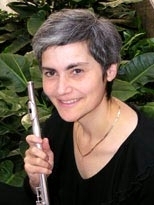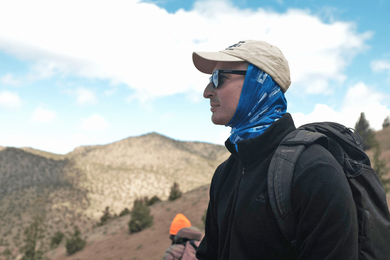Some of Boston's finest classical musicians will be at MIT this weekend performing works by some of MIT's finest composers. But the real star will be the flute.
"Flutings and Floatings," a concert this Sunday, Oct. 2, at 7:30 p.m. in Killian Hall, will feature Sue-Ellen Hershman-Tcherepnin, one of Boston's most active and prominent flute soloists.
Hershman-Tcherepnin, a founding member and flutist of Pro Arte Chamber Orchestra of Boston, will be joined by Lynn Chang, violin; Anne Black, viola; Joshua Gordon, cello; Robert Schulz, percussion; and Yukiko Ueno, piano.
The program will feature MIT Professor Peter Child's 1979 duo for flute and percussion; lecturer Elena Ruehr's "Law of Floating Objects" for flute and electronics (2000); Assistant Professor Brian Robison's "Cat's Cradle" for piccolo and percussion (1995); lecturer Fred Harris' "A Tern's Flight" for solo flute (1997); and Institute Professor John Harbison's "Six American Painters" for flute, violin, viola and cello (2002).
MIT composers have varying affinities for the flute. Ruehr has made a personal study of the instrument, having played it intensively between the ages of 8 and 20. Robison admits he's actually not fond of the flute; he wrote his piece to fill a programming need of a composer friend whose wife is a flutist.
Ruehr's original idea for "Law of Floating Objects" was to write a piece for flute, drums and prerecorded bird songs. Before composing, she studied bird songs through the use of computer-aided digital sound analysis. "The fluid, chaotic melodic phrases and rhythmic structures in 'The Law of Floating Objects' reflect the influence of bird songs, although I don't use the original bird songs in the piece," she says.
When Fred Harris composed his "A Tern's Flight," he too was inspired by birds. "Watching terns fish, using acrobatic ability to hover and then plunge, diving head first at a moment's notice, is a great treat," he said, calling it a "frenetic yet graceful dance."
Robison's composition has less airy roots, composed for three specific instrumentalists, on piccolo, drums and piano. "I banged out the piece in about three weeks," says Robison, wryly commenting that it turned out to be as good as, if not better than, pieces written at a more deliberate pace.
Child also composed his work for specific musicians, a couple that broke up before the piece even premiered. "Amor brevis, ars longa," Child said ("Love is fleeing, art endures").
Harbison's "Six American Painters" is a tribute to the American painters George Caleb Bingham, Thomas Eakins, Martin Johnson Heade, Winslow Homer, Hans Hoffmann and Richard Diebenkorn, inspired by specific paintings in the Metropolitan Museum of Art in New York City. "I wanted to find an instrumental combination that would draw, or graphically trace, these kinds of linear issues. So that's how I hit on the combination of flute and strings," Harbison said. "I associated the flute with gesture, with a graphic impulse."
Hershman-Tcherepnin received her undergraduate degree from Boston University and a Master of Music degree from the State University of New York at Stony Brook. She has performed with many Boston-area ensembles. With pianist David Witten, she frequently performs around the world as a member of D̼o Cl��sico.
Since 1985 she has been flutist with Dinosaur Annex Contemporary Music Ensemble, and was appointed co-artistic director of Dinosaur Annex in 2002. She has also taught at South Shore Conservatory (Hingham, Mass.), New School of Music (Cambridge, Mass.), New England Conservatory Preparatory Division, and at MIT since 1991.
For more information, call x3-9800.
A version of this article appeared in MIT Tech Talk on September 28, 2005 (download PDF).






